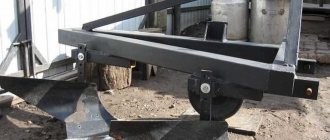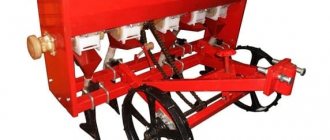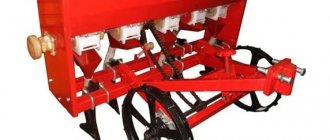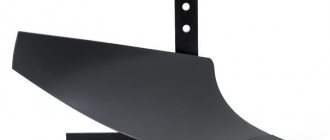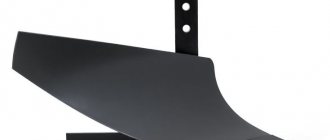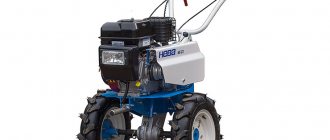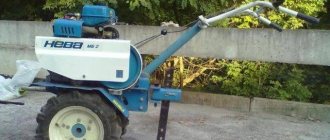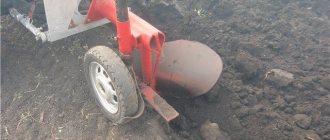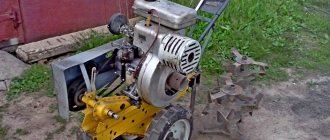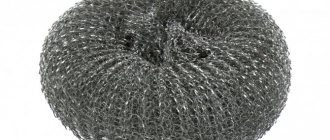Do-it-yourself plow to a walk-behind tractor from a horse-drawn tiller
An equally viable idea is to recycle an old horse-drawn plow into a walk-behind tractor.
A full description of the process is given in the video. A feature of all horse plows without exception is their heaviness, created by a bulky moldboard. If such a plow is installed on a walk-behind tractor without modification, the ground will not tilt.
This is a big plus, since the horse plow share will not undergo any changes.
To make a plow from a horse horse into a walk-behind tractor you will need:
- make your own blade, which is cut according to a pre-drawn drawing from a steel blank (3 cm thick). For accuracy, it is advisable to make a cardboard template;
- after cutting, the stainless steel blade is given a special shape;
- remove the horse blade and install a homemade one instead;
- remove the handles that were on the vertical axis;
- Instead, weld metal fasteners through which the plow will be hung to the walk-behind tractor.
- If during field testing it turns out that the converted horse plow does not throw well, the ploughshare should be slightly bent so that it can cut deeper into the soil.
Aggregation with mini tractors
Mini-tractors are usually called models of tractor equipment with a power plant with a power of up to 30 horsepower, the main application of which is soil cultivation in areas with a small area.
The traction characteristics of these tractors allow them to be combined with reversible single- and double-furrow plows, as well as disc and rotary plow mechanisms with low productivity.
Among the compact tractors produced today by MTZ-Holding, the most famous are the models produced by the Smargon aggregate plant MTZ-132N and 152, aggregated with plows from various manufacturers, including PU-00.000, 1L-230, 1LF-225, LS-225, LS-125 and other.
Hillers
Hillers allow you to cut furrows for planting crops, but their main use is hilling up potatoes to get a larger yield.
There are several types of hillers:
- Negotiable. This is the simplest type of hiller, which works using two plows.
- Disk. This option is more effective. It works using two rotating disks. Which rotate and loosen the soil.
- Active. This is a special type of hiller that works using propellers. If disk and revolving hillers simply turn over the top layer of soil onto the potatoes, then this one first chops it up and only then discards it.
From the manufacturer
The official manufacturer offers one version of the hiller - the universal reversible hiller OU-00.000-01.
Universal hiller
It looks like two connected plows. It is possible to adjust the width of the rows by rearranging the plows at different distances from 45 to 70 cm. The plow is immersed in the ground to a depth of 10 cm. The average speed of movement of Belarus with a reversible hiller is 4 km/h. The structure weighs 20 kg.
Analogs
The best analogue for any factory-made attachments for MTZ is Lida products. Including hillers.
Okuchnik OK-2
The OK-2 hiller is presented by a Lida company and has similar parameters to the universal hiller, except for the immersion depth. The maximum immersion of this unit is 12 cm. Accordingly, the speed in this case drops to 3 km/h.
You can always choose a universal option for a walk-behind tractor that will work successfully on it. The main thing is to choose a hitch.
Ukrainian offers a large amount of universal equipment, including disc hillers. Disc sizes can vary from 18 to 36 cm. Their maximum immersion level can be half the diameter. The disadvantage is that they are designed to process only 1 row, while reversible hillers work with two rows at once.
Homemade option
Making a disk hiller is problematic; a reversible hiller is much simpler in its design. To make it, it is enough to have two plows on hand, which are connected with bolts not to the Belarus, but to the frame. And the frame itself is already connected to MTZ.
Homemade hiller diagram
The frame should be made from a square tube in the shape of the letter “T”. This design is simple but effective and has been known since Soviet times.
Video reviews
Review of the universal hiller OU-00.000-01 for the MTZ walk-behind tractor
Setting up hiller discs on a MTZ walk-behind tractor
An example of hilling with a Belarus MTZ-09 walk-behind tractor
Here are some reviews from people who have already used this unit:
Gennady:
“When choosing between a disk and a reversible hiller, it is better to take a disk one. It is a little more expensive, but it works more stably and does not cut potato tubers. Based on practice, the rows are not always planted equally, and sooner or later you will hit some bush. But if you plant through a potato planter, I think there shouldn’t be any problems.”
Dmitriy:
“If you look at which hiller is better, then there is no definite answer, each is good in its own way. It is better to use the disk one until the potatoes have sprouted, or in the early stages of growth. It makes small lumps of soil, thereby saturating it with oxygen. After this, active growth of tubers occurs, and usually the next day sprouts are already visible from the ground. And with the current climate: plus 30 °C and no rain, this is what is needed. And the return one can already be used when the potatoes have grown and gained strength, without fear of damaging them.”
Owner reviews
Various reviews from owners indicate the need to use attachments when working with the Belarus MTZ 09N walk-behind tractor.
Maksim:
The use of various attachments for the Belarus walk-behind tractor is not a whim, but a necessity. With its help, work is carried out much faster, which helps save time, and more efficiently than manually. At first, only the necessary equipment was purchased - a plow, a mower. With use, requests and requirements for the walk-behind tractor grew. Now I can’t imagine working in the field without a hitch.
Design and technical characteristics of MTZ walk-behind tractor models
This device operates under any temperature and weather conditions. You can also upgrade it yourself.
The technical characteristics of MTZ walk-behind tractors are not inferior to similar foreign-made models.
Technical parameters of the MTZ-05 walk-behind tractor:
This equipment is intended for the following types of work:
- plowing soil of low density;
- harrowing;
- cultivation;
- inter-row processing of various vegetable crops (due to the design, which does not have a frame, the plants are not damaged during processing);
- transportation of goods whose weight does not exceed 500 kg.
The package includes an instruction manual, which describes in detail all the capabilities of this technical tool and the safety measures that must be observed during the work.
Indicators of MTZ-06 equipment:
2 reverse gears
This model is a technique produced by MTZ with an engine running on diesel fuel and a built-in air-type cooling system.
You can install additional equipment on the walk-behind tractor, such as a lug, hillers, cutters, etc. Additional equipment is connected using a clutch cable.
Technical parameters of model 08:
To connect additional equipment, a special coupling is provided in the design.
On the top cover of the housing there is a steering-type rod, on which the controls for the walk-behind tractor are located. The power transmission of a walk-behind tractor consists of a clutch, gearbox, main gear, differential and final drives.
This walk-behind tractor model has the following characteristics:
Among the advantages of this model are:
- Unpretentiousness to fuel. The power plant runs on AI-92 and AI-95 gasoline.
- Reliable body made of cast iron.
- It is possible to adjust the engine speed.
- No cables.
- Low noise level during work.
- Ergonomic handle.
- Wide selection of additional equipment. For example, a soil cutter, a universal hiller, a mounted blade, etc.
- The cylinder has a cast iron liner, which makes it possible to use the unit in difficult conditions.
Technical parameters of the heavy walk-behind tractor MTZ-12:
The walk-behind tractor is equipped with pneumatic wheels and a handle that can be adjusted in height and tilt. A manual gearbox with constant mesh gears is installed here.
On the MTZ 12 you can install a lot of additional equipment, the weight of which should not exceed 30 kg, for example, it could be a hiller, a snow blower, a cultivator, etc. It is also possible to convert the equipment into a mini-tractor.
Installing a plow on a MTZ walk-behind tractor
The MTZ walk-behind tractor is a universal wheeled vehicle that perfectly copes with any work in the field or garden.
When installing a plow for an MTZ walk-behind tractor, you need to remember that a wheeled walk-behind tractor can tilt to the side if it is not coupled correctly, thus interfering with work. Therefore, the plow is secured to the walk-behind tractor with a special kingpin, and either a universal or standard hitch is used. If you use this coupling method, you can reduce the resistance of the ground and eliminate the heeling of the equipment. Adjusting the plow on the MTZ walk-behind tractor is necessary to configure such features of working with it as:
- slope of the field board angle;
- depth of plowing;
- dump angle.
Only by knowing how to adjust the plow on the MTZ walk-behind tractor is it possible to obtain high-quality processing of a certain field for planting different types of crops.
Description of assembly work
Drawing of a simple plow for a mini tractor and walk-behind tractor.
The main load-bearing element of the equipment in question is the frame onto which the remaining components are attached. It is made of a metal profile with a round or rectangular cross-section, 2-3 mm thick. The working bodies and auxiliary elements of the plow are attached to the frame part. The shape of the frame corresponds to the number of working tools of the plow and the selected control elements.
You can also look at the drawings and assembly of the plow for the T 25 mini tractor
Geometric features of the plow
Plow share diagram.
The presented drawing shows the structure of the plow blade body of the plow. The share (I) is the lowest part that cuts into the soil. The layer of earth moves to the dump (IV), which turns over, crumbles and moves the soil into the furrow. The field board (II) serves as a guide for the movement of the plow and does not allow it to move towards the uncultivated arable land. The stand (III) secures the working tool to the supporting frame and rigidly holds the knife in working condition. The share consists of a toe, blade and heel (1, 2, 3), which ensure successful penetration into the ground. The upper, furrow and field edges (6, 4, together with the wing (5) and the mouldboard chest (7) due to their geometric parameters ensure proper movement and loosening of the formation. The design of the plow with two bodies allows for optimal plowing of small plots of land using mini tractors. On the Internet you can find many videos describing the operation of such devices.
Plow shank attachment
The stand is equipped with adjustment holes to adjust the required plowing depth. It is made of a metal plate 8-12 mm thick to provide sufficient rigidity to withstand high loads during operation. The stand is bolted to the frame; the angle of inclination of the body should ensure normal penetration of the cutting edge of the ploughshare into the soil.
Making a drawbar and fastening a wheel
Connection of the main components of the plow.
The frame is attached to the mini tractor using a standard pin coupling device or a homemade drawbar. The first can be taken from old, worn-out equipment and welded to the front part of the supporting structure, the second can be made with your own hands in the form of a drawbar with a handle (examples can be seen in various videos on the Internet). There are straight and V-shaped drawbars, with the second being more preferable. It dampens lateral vibrations of the plow and ensures straight movement.
One of the additional and control parts of a homemade land implement is a field wheel. It serves to ensure ease of movement and prevent the working tool from sinking into the soil. These tasks can be performed by one wheel, but on advanced designs these functions are divided into two elements. The field wheel is attached to the frame with an adjustable bracket to ensure the required plow settings.
Fastening and manufacturing of the working body of the plow
To make the main working tool of a plow with your own hands, you need to make a ploughshare and a moldboard. The plow body must be made of alloy steel with improved strength characteristics. In Soviet times, methodological centers of agricultural engineering advised strengthening plow bodies with spring steel overlays when cultivating parched and virgin lands. A good workpiece for the production of cutting parts is a used circular saw blade, the material of which has increased strength and rigidity. The ploughshare has a wedge shape with a working angle of 40-42º. It is recommended to attach the ploughshare to the blade with bolts or rivets to allow removal and regular sharpening.
Blade installation
The blade is made of a metal sheet 3-4 mm thick, followed by bending by gas welding or on a roller machine. It’s easier to make a homemade dump from a pipe with a diameter of 500-600 mm. First, a template drawing is made, then it is applied to the workpiece, cut with a gas cutter and sanded. The blade is rigidly mounted to the plow stand by welding.
Adjustment of equipment for a mini tractor is carried out on a level area with a hard surface. The field wheel is installed on a stand adjusted to the plowing depth. The ploughshare is lowered until it stops with the supporting plane, and the heel should be parallel to the surface of the ground. The stand is fixed in the selected position and the equipment is ready for use. To check that the plow settings are correct, you need to do a test plow.
The plow assembly is shown in more detail in the video:
Dimensions
The dimensions of different types of plows may vary. You can consider the parameters of parts using the example of a rotary specimen. It is taken into account that the rotary type of such a device is assembled from the following bases:
- side vertical part of the runner;
- horizontal plane below the skid;
- front dump part.
The most productive is considered to be a plow in which the cutting edge at the bottom of the fixed share is 20 mm below the bottom of the horizontal skid. Another correctly aligned part of the plow is the matching of the cutting edge on the side of the fixed share with the cutting edge on the side of the moldboard. The share and blade should not protrude more than 10 mm beyond the boundaries of the vertical plane on the side of the skid.
There is one more important nuance - fastening the front plane of the blade share without visible cracks and gaps, and in the same plane. If we look at these parts in more detail, they should be well polished and, like a mirror, reflect any surface. There should be no protruding fasteners under any circumstances. As soon as the plow returns from earthworks, it is advisable to clean it of settled soil and foreign particles. Elements that have been polished should be poured with oil or coated with grease. Next, the mechanisms need to be rubbed using a rag. In this way, it will be possible to protect the structure from aggressive external influences, which can lead to the formation of corrosion on the surface of the plow.
As for the 4th correctly constructed structure, it includes the flat front surface of the ploughshare, which makes an angle of 20 degrees with the flat part of the plow structure. It will be equal to the angle located at the rear of the exposed share. The cutting sidewalls-edges of the plowshare and blade will also have 20-degree angles with their bases on the side of the furrow. Moreover, the edge located on the side of the blade may be slightly rounded.
Distinctive features
Equipment from the MTZ plant is produced on the basis of Belarus tractors. The devices are produced in auxiliary workshops. Today it is a large complex that produces a wide range of high-quality equipment.
The first walk-behind tractor went on sale in 1978. It was called a walking tractor. It was quickly appreciated, noting the excellent quality of land cultivation.
IMPORTANT!
The main distinctive feature of walk-behind tractors is the presence of a tractor chassis, due to which it can be used to transport trailers with large cargo.
The devices are capable of reaching speeds of up to 10 kilometers per hour thanks to four forward gears. For simpler work, a speed of 2.5 km/h is provided. Control is carried out by a convenient steering column. Elements that control movement are located at the top of the structure.
There are three modifications of the cutter measuring 42, 60 and 70 centimeters. The walk-behind tractors are equipped with four-stroke carburetor engines with a three-liter fuel tank.
Power ranges from 5 to 8 horsepower depending on the model. By adjusting the power, you can use not only attachments, but also mills and circular grinders.
Mechanical gear and closed-type multi-disc friction gearbox provide high-quality transmission.
Efficient operation is maintained by the constant presence of oil in the clutch. The equipment can be supplemented with quick-change additional parts.
The machine easily copes with plowing the land, processing potatoes, mowing grass and other tasks. Locking wheel blocks and an internal power take-off shaft ensure comfortable operation.
When developing the machine, engineers took into account the specifics of the Russian terrain, as well as different types of soil. Thanks to this, the device is equipped with a gearbox that allows it to work on heavy soils.
A durable multi-tooth differential increases the reliability of the cultivator, and a comfortable steering column and wide wheels improve cross-country ability and controllability.
Review
In order for the purchase of an MTZ walk-behind tractor to fully justify itself, it is necessary to use all the possibilities that the design suggests.
Namely, connecting attachments. In all models, a power take-off shaft is provided for this purpose, with the help of which the equipment is controlled. Connection does not require special skills, as it is designed for a simple consumer. The only thing that the owner of a walk-behind tractor may encounter is the difficulty of connecting alone, since some models are quite heavy.
The tractor plant offers a wide range of attachments for the MTZ Belarus 09N walk-behind tractor. Among the wide variety, you can find a suitable device that will facilitate plowing, cultivation, grass cutting, transporting goods and harvesting. We will not list all models of additional attachments, but will focus on the most popular and in demand models.
How to choose a plow and cutters for the Neva walk-behind tractor
In addition to a good cultivator, a summer resident will need to purchase various additional attachments, of which there is also a wide range, so everyone can choose the necessary mechanism, from a plow and cutters to a trailer and a snow blower.
Let's look at the types of plows and cutters on such a popular walk-behind tractor as the Neva.
The Neva MB-1 walk-behind tractor is equipped with an American Briggs Stratton RS950 engine with a power of 6.5 hp, or a Japanese Subaru EXR16 with 6 hp. Suitable for processing sandy, sandy loam and loamy soil, can be used for transporting goods and cleaning areas. Provides the possibility of using a plow, cutters and other attachments. For this motor cultivator, it is advisable to purchase an additional support wheel, the presence of which will make it easier to loosen the soil, since it will prevent the unit from “burrowing” into the ground. For its weight of 70 kg, this is a fairly maneuverable device that performs its assigned tasks efficiently.
Neva MB-2 has a mass of 98 kg; an electric starter and a headlight are installed on it as additional equipment. The cutters included in the kit consist of 8 mechanisms.
MB-23 is the most powerful device included in this group of walk-behind tractors. Its weight of 105 kg allows you to perform the most difficult work using a plow.
MB-23SD is a modification of the previous model, but with a weight of 115 kg and power depending on the installed engine. The set includes cutters and a plow.
Neva with a Multi AGRO gearbox, which has a larger number of gears, the engines have less power, but at the same time it copes with traction functions perfectly, has a smaller turning radius, and there are internal ribs on the body of the walk-behind tractor.
MB-1 is equipped with either a Japanese Honda engine of 5.8 hp, or an American Briggs Stratton with a power of 6 and 6.5 hp. Has 1 reverse and 3 forward gears.
The MB-2 is equipped with a Briggs Stratton or Honda engine with 6.5 and 5.8 hp.
For each Neva walk-behind tractor described above, you can choose a plow, cutters and other attachments.
Types of plowing implements
To increase the efficiency of the work performed, it is extremely important to carefully consider the question: which agricultural implements are best to choose for motor vehicles. There are the following types of implements for plowing the soil:
There are the following types of implements for plowing the soil:
- double-body (2-sided);
- negotiable;
- disk;
- rotary (active);
- turning.
There are also several options for fixing them:
- trailed;
- mounted;
- semi-mounted.
Let's look at some soil cultivation devices in more detail.
Rotary (active)
A rotary plowing tool for motor vehicles is compared to an iron comb, which makes it possible to plow the soil. These types of agricultural implements of various modifications can have a variety of configurations. But these modifications are connected by the fact that their design becomes wider at the top, which makes it possible for these devices to pour soil to the side of the furrow.
An active plow actually has the same field of application as an ordinary implement for plowing the soil, with the only difference being that it functions faster and is more productive. However, there are certain features of its use. Thus, with a rotary device it is much easier to cultivate uncultivated lands that are abundantly overgrown with wild plants. The soil thrown away by the plowshares of this agricultural implement is better crushed and mixed, which becomes a plus when cultivating certain types of soil.
Reversible (rotary)
A tool for plowing soil of the reversible type is collapsible; this is probably the best option, since sharpening or rotation of the knife is possible.
You should decide what size the plow will be - which directly depends on what modification of motor vehicle you are using.
For more effective use of the implement for plowing the soil, it is necessary to adjust the tool; for this it is advisable to use a coupling device (it is possible without it).
To make adjustments more accurately, it is worth taking into account a number of basic provisions:
- it is necessary that the longitudinal axes of the unit and the regulator are aligned;
- vertical position of the beam.
Such an installation will make it possible to carry out agricultural work more productively. But it is also necessary to use extensions on the axle shafts and iron wheels with weights for all kinds of tasks.
With a drawing and certain skills, you can create a rotary plow yourself from steel with high structural strength. Therefore, it costs nothing for such a homemade device to withstand heavy loads while working on a plot of land.
When using this equipment for motorcycles, you must adhere to several recommendations:
- the device should not have a thin stand, a shortened blade, or a small thickness of the body sheet;
- An instruction manual must be present.
Double-body (2-sided)
Double-sided agricultural implements (hiller, also known as tiller, double-winged plow, tiller) are used to loosen the soil around plants, rolling it to the base of the stems of various crops. Additionally, weeds are eliminated between the rows. With such tools, you can cultivate the ground, cut furrows for planting plants, and then fill them up by turning on the reverse gear of the unit. Such designs are distinguished only by the width of the working grip - variable and constant. The difference between them is solely in the moving wings, which adjust the width of the working grip.
A device that, with a constant working width, operates with light motor vehicles (up to 30 kilograms), with a motor power of up to 3.5 horsepower. Their distinctive feature is 12 mm racks (protect the unit from overloads).
The most common types of hillers are devices with variable working width. Their only drawback is that soil falls into the furrow after passing. Such equipment comes with units weighing more than 30 kilograms, with motors with a resource of 4 liters. With. and more.
Original equipment
The manufacturer presents a multifunctional modification of the PU-00.000-01 reversible implement for plowing land, which is adapted for the heavy Belarus MTZ 09 N walk-behind tractor, but is not suitable for every MTZ. It can handle plowing soil of any density, including virgin soil. As a distinctive feature, you can focus on the small mass of the device, which is only 16 kilograms.
Preparation for installation
Equipping motor vehicles with plows that are structurally different from tractors has some peculiarities.
To assemble equipment on a light walk-behind tractor, pneumatic wheels are replaced with metal wheels (lugs), designed to reduce the load on the walk-behind tractor when plowing. The lugs are mounted using specialized hubs installed instead of transport wheel holders on the axle. The long lug hubs, which increase the stability of the unit during plowing, are fixed on the drive shaft by means of studs and cotter pins.
Particularly convenient for operating with motorized equipment are soil plowing implements with a weight of up to 60 kilograms and a working width of 0.2 to 0.25 meters.
Along with this, an auxiliary ballast weight weighing from 20 to 30 kilograms is mounted on light motor vehicles, increasing stability during operation.
Units used for plowing soil must have at least 2 forward speeds, one of them must be reduced.
It is undesirable to use units with one gear and weighing up to 45 kilograms for arable work.
How to install?
Both plows designed to operate with certain modifications and multifunctional devices that operate on the bulk of the units are mounted on walk-behind tractors.
A tool for plowing soil on a MTZ Belarus 09N walk-behind tractor is mounted using a standard or multi-purpose coupling device. It is recommended to fix the hitch on the cultivator using one king pin. With such a fastening, which has a 5-degree horizontal free play during plowing, the coupling device reduces the soil resistance force affecting the unit and prevents it from deflecting sideways, reducing the load on the plowman.
To connect the plow and the coupling device, vertical holes located on its stand are used, which are additionally used to adjust the plowing depth.
Do-it-yourself plow for a mini tractor - drawings, assembly from hitch to blade
Moreover, there are plenty of various metal parts lying around in old garages in our rural areas. We offer our readers one homemade model, which has received many positive reviews on the Internet.
We invite you to familiarize yourself with DIY drinking bowls for rabbits in winter
A homemade plow for a mini tractor, drawings for it, dimensions and a description of the design can be found in this article.
The homemade plow in question for a mini tractor can be assembled in a few free evenings. And it is assembled from old metal pipes, plates, and corners. To work you will need:
- Welding machine;
- Metal scissors;
- Metal rectangular pipe dimensions 52x40x7 mm;
- A half-inch metal pipe, you can take an old one from the heating system.
- Bolts M10;
- Getinax sheet 25 mm;
- Wheels from a children's bicycle.
- A little patience.
The plow is used with mini tractors less than 12 hp. It can be used as a swing cultivator, hiller, furrow digger, or plow. Thanks to its unusual and simple design, it will cope with the work efficiently and on any soil. It can be aggregated not only with a mini tractor, but also with a motorized ball, and if desired, disconnect the rods, attach tugs and use them with horses. Below is a drawing diagram of the design.
Homemade garden plow for a mini tractor or walk-behind tractor: 1 - handle made of pipe, 2 pcs; 2 — beam frame; 3 — fixing the stand with an M 10 screw; 4 - plow; 5- mounting fork of the hinge to the frame; 6- drawbar from the pipe; 7 - wheel; 8 — hub-bearing made of nylon material; 9 — pipe handles; 10 — hinged axis made of M 10 bolt; 11 - lock nut; 12 — wheel axle; 13 — remote nylon washer; 14 — handle for the drawbar; 15 - tee.
The frame is taken as the base - the guild, the drawing can be viewed below. You can make it from a piece of metal rectangular pipe with thick walls 52x40x7 mm. A fork is made for the support wheel. To do this, two wider walls are cut off on opposite sides.
There is also a hole at the back of the frame, which is welded with a rivet. A round hole of 11 m is drilled in the rivet. An M10 nut is first welded onto the rivet.
If you decide to build a blade or plow for motor vehicles, then you cannot do without drawing up detailed and correct drawings. The reliability and wear resistance of a homemade part largely depends on its well-designed design. Based on the rich experience of professionals who regularly make good plows for walk-behind tractors, it is recommended to make the ploughshare in such a way that it can be easily and quickly removed. With this function, sharpening this part will be significantly simplified, and you can safely resort to it before plowing the land on the site.
For the manufacture of the cutting component of the plow, 9XC alloy steel is best suited. The material is used mainly to make discs intended for simple hand saws. You can use steel marked 45, which was brought to the optimal level of hardness during the hardening process. If you only have simple steel, for example carbon, which cannot be heat treated, then by removing the cutting edge (using an anvil) and then grinding it off, you can safely use the steel for working with the soil.
When independently drawing up a drawing of a future plow, it is recommended to rely on accurate diagrams. The do-it-yourself structure will be assembled from the following components:
- a metal pipe that acts as a load-bearing part;
- wheels necessary to move the structure on the ground;
- working cutting part with or without blades (you can fix the cutting elements of old devices);
- attachment mechanism to the walk-behind tractor itself.
- The plane of the slide is lateral.
- Bottom horizontal.
- Front dump.
A typical diagram of a simple homemade plow consists of:
- Two handles made of steel pipe.
- Frames.
- Stand clamp with screw size M10 or M8.
- Mounting fork for frame hinge.
- Drawbar.
- Bearing.
- Jumpers between handles.
- Joint shaft.
- Locknuts.
- Adjusting washer.
- Drawbar handles.
- Tee.
Depending on the type and purpose of the inventory, this list may include other elements.
We suggest that you familiarize yourself with Dandelion Extract instructions for use. Dandelion tincture with vodka: recipe for flowers and roots
Useful tips and tricks
If you decide to build a good plow for a walk-behind tractor with your own hands, then you should listen to useful recommendations from experienced craftsmen.
If you plan to build a double-furrow plow, then you should remember that it must have two shares. This device can be used for plowing various types of soil.
This is the best specimen for working with stagnant soil. When making a rotary plow, it is very important to ensure that the edges of the moldboard and the ploughshare coincide. These elements are connected as tightly and firmly as possible
There should be no gaps or noticeable cracks. After using the plow, it must be cleaned of any dirt and adhering particles. Only if this rule is observed can we talk about the durability of the structure and its wear resistance. And then you won’t have to constantly sharpen the cutting plate. It will be much more convenient to install the plow on the agricultural machinery itself if you place the walk-behind tractor on stands. These can be not only special supports, but also simple bricks or stones/boards. Particular attention is paid to the already constructed plow. If it has only one bolted connection and only one hole, then it will not be adjustable.
It is advisable to assemble a plow with a support wheel on a steel sheet. All surfaces will need to be cleaned and polished. The back surface of the welded share is made as smooth as possible. Popular rotary plow types are in most cases made with disk mechanisms, but there are also drum, shovel and auger types. Such structures are simply irreplaceable when applying fertilizers and controlling weeds. For independent work, it is advisable to use only high-quality plumbing tools. You need to be able to work with them. At least minimal experience is required. Do not forget to process the working edge of the manufactured plow from time to time.
This will make her work more efficient. When making your own plow for a walk-behind tractor, it is important to strictly adhere to the chosen technology and the drawings drawn up. The slightest mistake or omission, which may seem insignificant, can lead to poor quality work of the structure.
Then it will need modification.
To learn how to set up a plow for a walk-behind tractor, see the following video.
https://youtube.com/watch?v=Y2CMyUV2fNc
Homemade attachments
When the finished mini-tractor has passed all the tests, acquired the status of significance and earned the love of the entire family, the task of manufacturing attachments for it comes to the fore. And this depends on the intended crops and soil cultivation. If a walk-behind tractor was used to create a tractor, then there is a ready-made unit for coupling with agricultural implements. Otherwise, you will have to make a canopy with your own hands, a photo of which is presented.
It shows that the hitch has a three-point design. It must be movable both vertically and horizontally. Made from steel profiles using a welding machine. Needed for connecting units.
Of course, it is possible to make a single-point hitch unit, but this will greatly reduce the number of mounted agricultural machines and, consequently, reduce the versatility of the tractor.
There are several types of agricultural implements for cultivating land.
Types of plows
For homemade tractors, the following types of plows are most often used: single-body and double-body. The former cling to light and medium-sized walk-behind tractors, while the latter cling to more substantial equipment. For a mini-tractor, if it has a powerful engine and decent weight, multi-body moldboard plows are prepared, which are attached to a homemade hitch.
The plow is often made from the skimmer of a factory plow, which is usually used by the MTZ tractor. It is only necessary to slightly modify the plowshare and the correct bend of the blade. It is possible to use a horse plow.
For plowing heavy and hard soils, as well as soils with roots of trees and shrubs, homemade disc plows are used. They are a frame with sharp disks with a diameter of up to 40 cm, which cut into the soil at a slight angle relative to the direction of movement. This allows them not only to cut the roots, but also to loosen the soil.
Hillers and harrows
Any homemade hiller consists of a frame and two disks located at an angle to each other. This unit is used for hilling rows of potatoes and strawberries.
Harrows are designed to break up clods and loosen plowed soil. They consist of a lattice frame measuring 100x50 cm, welded from 50x50 mm corners, and sharp fingers up to 15 cm long, spaced evenly over the frame area. The harrows hitch behind the plow and work together with it.
Potato planters and diggers
This mounted trailed equipment is used for a specific crop – potatoes. It is powered by its own wheels, which allows the seeds to be evenly distributed along the furrow and does not depend on slippage.
A potato digger is a sharp knife 20-30 cm wide, which goes horizontally into the soil to a depth of 20-25 cm. Using an inclined grid, it pulls the potatoes to the surface. At the same time, the tubers are cleansed from soil and grass.
Other equipment
Depending on the purpose, other attachments can be used:
- Mounted mowers. They are used for making hay for domestic animals and removing weeds in the garden.
- Rake for raking up grass clippings. They are mounted and trailed. Trailed ones have two wheels. Hitches directly to the tractor.
- Mounted cultivators. They usually consist of a frame and 6-8 cultivator tines. The operating principle is similar to that of a flat-cut plow. They have two wheels with which the depth of cultivation can be adjusted.
- Garden sprayers. This is the required unit. They spray cultivated crops to protect them from pests, and also protect grains from weeds using special chemical compounds. Mainly used in farmers' fields.
- Bulldozer blades. They are hitched in front or behind the tractor. They are a shovel up to 1.5 m wide. They are made of steel 3-5 mm thick. Attached using a hinged device. Designed for clearing the area of snow and debris, as well as for leveling the surface of the site.
- Coons. This special device is used only for loading and unloading operations. Manufactured for a specific type of mini-tractor activity.
- Rotary brushes and snow blowers. They are especially necessary in winter on city streets. A tractor with such equipment is able to clear all the bottlenecks between houses and shops where it is difficult for an ordinary tractor to reach.
Assembling a simple unit, as well as homemade attachments for a mini-tractor, does not present any particular problems. All you need is time, desire, the necessary tools and materials.
